
Northeast Asia onboard Azamara Quest 2009
Thursday, 9 April 2009

Brooks Blog
A personal account of the 27th ‘Music at Sea’
A Northeast Asia Adventure onboard ‘Azamara Quest’
March 14 - 28, 2009
Beijing (Tianjin), China - Dalian, China
Seoul (Incheon), South Korea - Kyoto (Osaka), Japan –
Hiroshima, Japan - Busan, South Korea - Shanghai, China
Hong Kong, China
A previous visitor to China, Marco Polo, described a palace in Beijing ‘altogether so vast, so rich and so beautiful, that no man on earth could design anything superior to it’. Had he been writing in the 21st century he might have been referring to the Peninsula Hotel, our base for the three day pre-cruise Beijing package arranged by John and Rose. Liberace used to claim that ‘too much of a good thing is…..absolutely WONDERFUL’ and he was correct! From the loggia housing shops bearing the names of Cartier, Harry Winston and Tiffany to the grand entrance where two green Rolls Royce Phantoms lay slumbering ready to spring into service at a mere crook of a bellman’s finger, this was opulence on a grand scale. Had it not been for the ‘must sees’ of the Great Wall and the Forbidden City we might never have strayed outside the cocooned walls of this temple to overindulgence. Something not quite right here – isn’t China a communist country? One only had to look outside to witness the tremendous gap between the ‘haves’ and the ‘have nots’ in modern China. Glancing through the window one morning I noticed an open cart with a small driving area attached, struggling through the busy Beijing traffic. Its natural habitat would have been a farmyard or country lane, certainly not this three lane highway jostled by aggressive Audis and BMWs. Sitting in the back, surrounded by vegetables and seemingly oblivious of the traffic and lack of privacy, a raggedly dressed peasant woman was breast feeding her baby. What did the future hold for that child? In the communist doctrine all men are equal, but, as George Orwell put it, some are more equal than others!
Azamara Quest was waiting for us in Tianjin - translation ‘port to heavenly capital’ (strange having a ’heavenly capital’ in an aetheist country, but it obviously harks back to their Buddhist roots). Like her twin sister, ‘Azamara Journey’, she is an adorable, intimate and superbly comfortable vessel. A further ‘plus’ for us was the prescence of Cruise Director, John Howell who is always a good friend to ‘Music At Sea’. Now dear reader, visualise being part of the cruise ship management structure on turnaround day with responsibilty for closing up the paperwork for the previous cruise, disembarking 675 passengers, cleaning the entire ship, refuelling, stocking up with provisions for 2 weeks and then getting ready to embark another 675 all in the space of a few hours! Exactly - and on this day there was an additional problem. A sick crew member needed urgent surgery ashore and didn’t have a Chinese Visa. You do NOT what to know how many hoops you need to jump through to arrange a visa on a Saturday afternoon in Tianjin. At one stage there was the possibility the ship’s departure might be so late we would need to omit our first port – Dalian, China – and go straight to South Korea. The reaction of the Tianjin officials was ‘If you don’t visit China tomorrow this will become your last Chinese port so all passengers will need to clear Chinese immigration today’ - which they suggested could be held shoreside commencing at midnight! Now the reason I tell the story is that as Cruise Director John was involved in the negotiations but he still found time to be on the pier to welcome us without giving a hint of the pressure he was under. Don’t ask me how it was resolved, but it was, and steaming out of Tianjin only an hour behind schedule (brilliant) we docked the next day in the youthful (by Chinese standards) city of Dalian, a centre for outsourcing by Japanese high tech companies and China’s answer to Silicon valley. Sometimes Dalian is referred to as the Hong Kong of Northern China which would have stunned the Russian and Japanese settlers who drew up the original plans for this city of lawns, squares, fountains and gardens. Their goal had been to create another Paris!
Bidding a temporary farewell to China we docked the next morning in Incheon (the port for Seoul in South Korea) at a tense time. The North Koreans were about to test a rocket and the atmosphere in this second largest metropolis in the world was tense. I offer congratulations and thanks to the local people as whatever stress they privately felt did not affect their warm welcome for us. We had a wonderful time, especially the one of us (he shall remain anonymous) who took the Incheon Panoramic tour but saved the ticket as an example of the importance of ‘reading the small print’! See illustration and read the last phrase carefully!!

Panoramic Incheon Tour – or was it?
Whilst on the subject of language: we were discussing the economic situation when one of the group said “I may have to cut back on either the Mercury or the Infinity”. As these are the names of two Celebrity ships I assumed we were talking cruises. WRONG! He was going to sell one of his cars!
After a relaxing day at sea (and our first concert) we met in the main lounge early the following morning where masked men in uniform were giving orders to the ship’s officials! A highjacking? No, Japanese immigration and health inspection for Kyoto, our port for 2 days and birthplace of the 1997 greenhouse gases protocol. Take it from me, these guys take their job VERY seriously and had installed a mass of electronic wizardry onboard to check passports, fingerprints and monior body heat. Body heat? Yes, the first line of defense against Avian flu.

Tokaido Shinkansen
Kyoto, only 2 hours and 22 minutes from Tokyo by the Tokaido Shinkansen (bullet train), is the centre of the Japanese film and television industry, but standing on the open deck this early morning I was transported back in time to another world. The filigree cobwebs of the delicate mist enveloping the surrounding hills were cloaking this historic city, for more than 1000 years the nation’s capital, with a veil of shimmering translucence and it was easy to understand why, with nearly 2000 temples and shrines, it remains the spiritual and intellectual centre of Japan. Thank goodness the beauty and history of Kyoto saved it from saturation bombing during the second world war for today it is the ONLY Japanese city with a good selection of pre-war buildings including the original teahouses locating geishas. The term ‘Geisha’ is frequently misunderstood. It means ‘artist’ (so can I claim to be a geisha?) and requires a long training in the traditional skills of calligraphy, ancient dance, conversation, singing, and playing the Shamisen (OK, I can’t claim to be a geisha). Geisha numbers have dwindled from around 80,000 in the 1920’s to approximately 2,000 today so I’m writing about an endangered species. By a strange coincidence, shortly after our visit, the International Herald Tribune carried an article about the Geishas of Kyoto being harassed by tourists grasping and damaging their kimonos which can can cost upwards of $20,000 USD. In their traditional high wooden heels the poor girls are unable to run away (I would imagine so – I’ve never tried it) Who were these evil predators? The IHT didn’t name and shame but I’m sure it was none of us!
Navigating amongst the many small islands here it is easy to be seduced by the tranquil beauty of this paradise – one almost expects a a choir of mermaids to rise through the ocean mists singing Bali H’ai – but the reality is that Japan has been the scene of devastating conflict, heartbreak and bloodshed. Okinawa, where in 1945, following the largest build up in naval history and a battle lasting 82 days, 12,000 Americans, 107,000 Japanese conscripts and an estimated 100,000 civilians lay dead.
Amongst the many personal tragedies were 200 Japanese schoolgirls and their teachers who committed suicide rather than be captured. And now our itinerary included a name synonymous with instant, brutal and heartbreaking death: Hiroshima.
On a bright sunny morning, 08.15 on August 6 1945, An American B29 detonated an atomic bomb (with masterly understatement named ‘Little Boy’) 600 metres above an upscale residential and trading area of downtown Hiroshima sandwiched between the Otagawa and Motoyasu rivers. The force of the blast was the equivalent of a 1000 mile-per-hour wind. The land beneath reached a temperature of 4,000 degrees celsius and instantly almost everyone and everything in the vicinity was reduced to scorched rubble. The lucky ones died instantly. The unlucky lingered, limbs blown off, skin ripped apart and gasping for water. The recurring theme in the recollections of the rescuers is of barely recognisable human creatures begging for water on this hot summer day. In their badly burned state water would have killed them instantly, as those who struggled into one of the two rivers tragically discovered – thousands of corpses clogged the river bank. By year’s end over 160,000 were dead and the long term effects have seen that figure rise to over 200,000. The area is now a Peace Park with water as a recurring theme. As part of my visit I walked around the Memorial Hall where photographs and names of over 16,000 of the victims constantly scroll on electronic screens and where the visitor can search the computer database for specific names amongst the dead. Outside in the Park people were in front of the memorials, heads bowed silently in prayer and meditation. Sensing that I was intruding into the private grief of those with vivid and personal memories I left feeling uneasy, walking down a thoroughfare where the motto ‘Promenade of Peace’ is engraved at regular intervals into the sidewalk.

Engraving on the sidewalk in Hiroshima
I couldn’t help but reflect on the message of the Peace Park which is that nuclear weapons should be abolished. But why stop at nuclear weapons? One death or one hundred thousand deaths. It makes no difference to those who are killed or lose loved ones. So much of our current culture - movies, books, songs - glorifies violence and result in the tragic consequences so apparent in our everyday lives. If only our technical development could be equalled by spiritual development. But - but - but perhaps it has? Since August 6 1945 the ‘still small voice of reason, crying in the wilderness’ at that time associated with cranks has now become a deafening yell from the mainstream. Even the most bellicose realise that since we now have the ability to destroy our planet we MUST find another way to resolve our differences. Within 6 days of ‘Little Boy’ the war was over and Japan, a nation notorious for brutality began its transformation into a major force for peace. Gradually my unease turned to optimism reinforced by another memory from the Peace Park. That of the cherry blossoms. To the Japanese the extraordinairy frailty and beauty of the cherry blossom signifies the ephemerality of life and hope of rebirth. That day there were many Japanese families picnicking in the shade of the blossoming cherry trees which now grow in the Peace Park. Where there was only death there is now life – and where there is life there is hope.
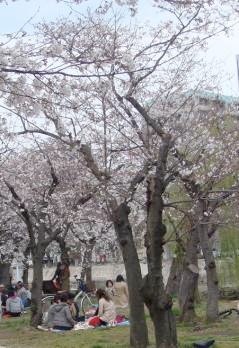
Picnickers under the Cherry Blossom, Peace Park, Hiroshima
Also engraved at regular intervals in the Promenade of Peace sidewalk, were images of Koi carp and my curiosity revealed that the Japanese associate the Koi with perseverance and courage. With the salmon it is the only fish known to swim upstream and legend has it that if 100 Koi swim up the Yellow river as far as Yellow River Falls they will turn into a dragon which protects all around. I confess I didn’t count but I shall always dream that are at least100 Koi carp embedded in that sidewalk and long may their protective dragon guard this beautiful, welcoming and gracious city.

Koi carp in the sidewalk, Hiroshima
My other memories of Japan are the extreme courtesy and the pleasant custom that when purchasing goods one does not hand the money directly to a cashier but places it in a small tray which the cashier then takes and returns any change the same way. However, I do have a negative! Think Japan and you also think cutting edge technology. Sounds of baby pigeons and cuckoos emanating from the pedestrian crossings are fine – even soothing, but please, I beg you, ban all gizmos from rest rooms! In Hiroshima I encountered the ultimate nightmare. A heated lavatory with two heat settings (low and high) plus ‘shower and bidet’ (adjustable spray strength) operated by a command module attached to the side of the basin!
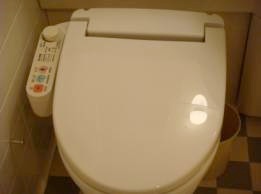
Your chariot awaits!
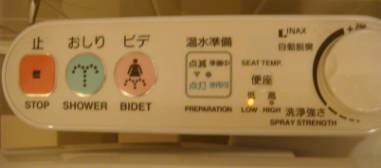
Command module – read carefully and fasten your safety belt
Who would think to check a lavatory for this? Like anyone else I went straight in and sat down. Yaroo! – the previous occupant had left the seat heating on ‘High’! Involuntararily leaping up I bashed my head on the opposite wall which caused me to bounce back with a heavy thud right onto that infernal scorching seat from hell which, angry at being disturbed, went into a demonstration of its full power bidet effects on me, a helpless and dazed victim. What sick person designed this? And who for? – Captain Spock? No. This is taking obsession to far!
En route to Shanghai we stopped at Busan in South Korea where there were more memories of war in the shape of the UN cemetery, the only one of its type in the world, and the final resting place for UN soldiers killed during the Korean War. It would be so wonderful if this whole area could say ‘goodbye’ to war and look to a peaceful future. Busan is certainly doing that – they are bidding to host the 2020 Olympic Games!
And so to Shanghai, once known as ‘the Paris of the East’. The city where the Chinese Communist Party held its first meetings in 1921 and where the Red Guards were created in the 1960’s. Now 18 million inhabitants (and 72 Starbucks!) call it ‘home’ and the Quest docked at the new Passenger Ship Terminal (this would not have been possible on a big ship) with a wonderful view of the river bustling with activity and the new and unusual architecture. Thoughtfully Azamara provided every guest with written Chinese instructions to assist in getting to and from the main areas, but today they would not be needed as we were looking forward to our special MAS shore excursion.
As we disembarked the Quest under slate grey skies our cheery guide Lily greeted us waving a large Daisy with the advice ‘follow the Daisy and you find the Lily’. Her opening remarks - ‘This is our driver, he’s very good. All drivers are good in China, bad ones are dead!’ – prefaced a seemingly inexhaustable fountain of wit and information. Always pointing out and accommodating our ‘Kodak moments’ she proved an exuberant, knowledgeable and fun guide. “So much construction work here we say the crane is our national bird” she chirruped - and modestly mentioned that whereas it had taken New Yorkers fifty years to create the celebrated Manhattan skyline the Chinese, by working 24 hours per day in 3 shifts, had performed a similar miracle in Shanghai in only 10! That the new buildings are spectacular is unquestionable but what also impressed me was the desire to incorporate Chinese culture and history into their design. The Pearl TV Tower is inspired by a Tan dynasty poem about the haunting sound made by a lute.
This photo was taken from our pier in Shanghai. The Pearl Tower, 1535 ft., is on the right with the two spheres. The Shanghai Financial Center (blue outline) is the tallest in China at 1614 ft. and is the 2nd tallest building in the world. (looks like a giant bottle cap opener). The Jin Moa Tower (center) is the 6th tallest in the world. The Pearl Tower's closeness makes it appear to be the tallest..

The National Museum, (‘stay together like sticky rice’ commanded Lily, her upright Daisy pointing us towards the entrance) is shaped like an ancient, bronze, tripod cooking vessel called a ding. The building has a round top and a square base, symbolising the ancient Chinese perception of the world as ‘round sky, square earth’. And where was China situated on this square earth? The answer lies in its name. China (literally ChungHua) translates as ‘the country at the centre’ – not for nothing is it known as the Middle Kingdom!
Silk is one of many Chinese discoveries and death was the penalty to anyone disclosing the secret production process. But in 552 AD two monks with silkworm eggs hidden in their walking sticks smuggled them to Byzantium and the secret was out. We visited a silk factory. Did you know that moths will not eat silk? If they did it would be cannibalism! Strange that someone my age did not realise this earlier! Back in the coach Lily piled on the statistics. The Chinese alphabet has over 3,000 characters and the dialects of China are more varied than the languages of Europe! That’s pretty staggering to digest before lunch which we ate at a Dim Sun restaurant patronised in the past by Queen Elizabeth and Bill Clinton! Sure enough there were pictures of them on the wall. She looking sweet and him looking sour (not true – just checking you’re awake for my Chinese restaurant joke. It must be the influence of Lily) and then after a walk around a traditional Chinese Garden we boarded our coach for what was, for me, the highlight of a memorable day. We were privileged to be given access to a Children’s Palace, which is where gifted children can go to to develop their artistic skills. Although we were running late the children waited for us and put on a real humdinger of a show. We loved it, cheered lustily, gave them a standing ovation and were sad when once more ‘staying together like sticky rice’ we obediently followed Lily and her daisy back to the coach.
On the return journey she took questions, Lily – not the daisy! Curious about the numerous street traders offering ‘Rolex’ watches with impunity we asked her about the ‘fake’ industry in China. With regard to DVD’s she told us that foreign film imports were limited by the government to 39 titles per year so in many cases a DVD ‘knock-off’ at $2 was the only option. At this point let me interject a word of advice. NEVER buy fake technology. Whilst in Beijing some crew members, tempted by the bargain prices, bought disk storage devices which, once connected to their computers, erased all the information on their hard drives. Another unfortunate purchased an ‘iPhone’ which lasted exactly one week! This reminds me of a travellers complaint I read in the newspaper recently: "We bought 'Ray-Ban' sunglasses for five euros ($6.50) from a street trader, only to find out they were fake."
Meanwhile, Lily was in full flow. In response to a question about the new President of the USA she responded. ‘We’re happy he’s President – if he can make it so can a Banana’. WHAT did she say? (When you’re in a country whose government refers to the last British Governor of Hong Kong as a ‘pink prostitute’ or the Dalai Lama as ‘a jackal in monk’s clothes’ how much political correctness should you expect?) Lily’s timing was brilliant, pausing dramatically she waited until even the most dozy was bolt upright, then, giggling happily, she continued: ‘Not what you think – in China we say Chinese Americans are like ‘Bananas’ – white on inside, yellow on outside – so maybe a Chinese American will one day be President of the USA. Everybody applauded, and Lily, now on a roll, climaxed her commentary with excellent impersonations of Londoners talking cockney rhyming slang! You had to be there! My surreal experience was complete. When I return to China, Lily will be my guide!

Lily is in the red silk jacket and Molly, who wonderfully handled the second motorcoach is on the right. Rosemary and John were all smiles at the end of our private tour Rosemary arranged for us.
As we approached our final port, Hong Kong (translation: Fragrant Harbour) the mass of high rise concrete and cranes rising out of the mist gave the illusion of an eastern Brigadoon. Many of us went to the Peak, famed for its spectacular panoramic views, but unfortunately all we saw were spectacular panoramic views of the fog, perhaps left over from the time this island was under British administration. When the British left in 1997 China promised to continue as before with ‘one country – two systems’, and to this casual observer, capitalism seemed alive and thriving! Here there are more Rolls Royce cars per square mile than anywhere in the world and so many designer perfume shops, I thought they could be the reason behind the island’s name!
Adjacent to our dock the huge shopping mall of Harbour City, heaving with customers, had an astonishing variety of goods some of which I had not seen before. Fancy a Häagen Dazs green tea icecream with red bean topping? Then this is your place. No problem!
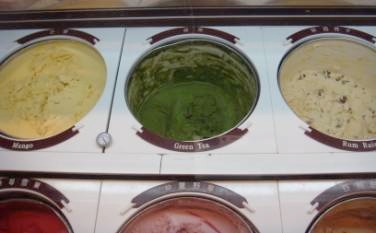
Green Tea ice cream anyone?
As I drove to the airport., another shopping mall but with planes attached, the metropolitan area gave way to beautiful countryside similar to the French Riviera. It was almost time to return to reality but, after take-off, gazing through the plane window as we floated above a duvet of bubbly white clouds I reflected on the last two weeks. A kaleidoscope of memories to savour and treasure. For two weeks we had experienced at first hand Asian culture, sights and traditions. Each port a package of surprises to be unwrapped and enjoyed like a never-ending Russian Matryoshka doll. We had enjoyed all this secure in the knowledge that at night we could return to the traditional western comforts of our ‘home from home’ the Azamara Quest. Thank you Azamara for hosting us, thank you John and Rosemary for putting it all together, and, most important of all, thank you dear Music At Sea participants for making Music At Sea what it is. A unique musical programme combined with the finest cruise experience money can buy. Cruising is a wonderful way to see the world and astonishing value. Next year (2010) we shall be 10 years old and we’re going to have a party! I hope you’ll join us!
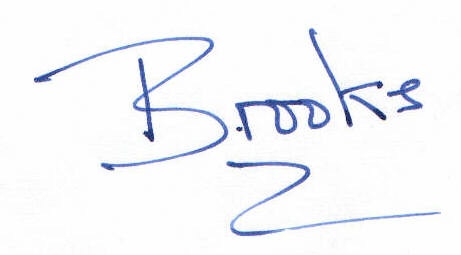
London, April 3 2009
